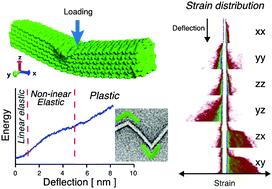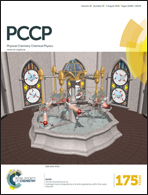Linear, non-linear and plastic bending deformation of cellulose nanocrystals†
Abstract
The deformation behaviour of cellulose nanocrystals under bending loads was investigated by using atomistic molecular dynamics (MD) simulations and finite element analysis (FEA), and compared with electron micrographs of ultrasonicated microfibrils. The linear elastic, non-linear elastic, and plastic deformation regions were observed with increasing bending displacements. In the linear elastic region, the deformation behaviour was highly anisotropic with respect to the bending direction. This was due to the difference in shear modulus, and the deformation could be approximated by standard continuum mechanics using the corresponding elastic tensors. Above the linear elastic region, the shear deformation became a dominant factor as the amplitude of shear strain drastically increased. Plastic deformation limit was observed at the bending angle above about 60°, independent of the bending direction. The morphology of the atomistic model of plastically deformed cellulose crystals showed a considerable similarity to the kinked cellulose microfibrils observed by transmission electron microscopy. Our observations highlight the importance of shear during deformation of cellulose crystals and provide an understanding of basic deformations occurring during the processing of cellulose materials.


 Please wait while we load your content...
Please wait while we load your content...